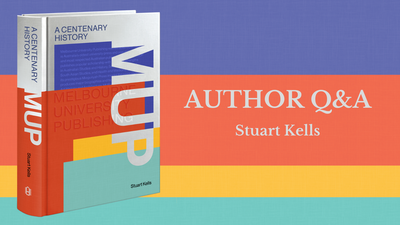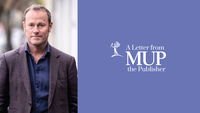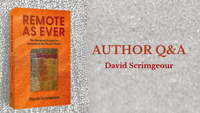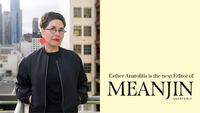Q & A with Stuart Kells—Author of MUP: A Centenary History

1. Why did you want to write about the history of Australia’s oldest university press?
I relished the opportunity to write about one of Australia’s most important publishers. Many details of MUP’s history are not widely known, and with the press reaching its centenary, the timing for the book was just right.
I’ve always been interested in books and publishing, and I have a professional interest in the history of institutions and the history of Australian politics and culture, so this book was a ‘sweet spot’ project.
There was also a personal element. I spent more than a decade studying and working at the University of Melbourne. I lived in a bookish part of Carlton, surrounded by bookshops, book warehouses, printeries and publishing houses. MUP was of course one of those, and I’ve long been a fan of its publications.
The book I’ve written is a tale about printing, cover art, design and the daily texture and the ins and outs of running a publishing house. It is a celebration of book culture and an exercise in nerding-out about the physicality of books—their bindings, jackets, typefaces, paper stocks, production triumphs and production disasters—as well as their content.
2. What did research into Melbourne University Publishing’s history involve?
MUP has a large and fascinating archive, and so does the University. Those collections formed the core of my research. I used evidence from letters, board minutes, publishing proposals, manuscript assessments, corporate documents and other records. I had unlimited access to a treasure trove of material.
Looking through the archives, I was continually surprised. Authors, episodes and connections came up unexpectedly in every era of the press. I didn’t expect to be writing about Colleen McCullough, for example, or Cole’s Book Arcade, or the Ern Malley affair.
And of course as part of the research, I looked at the books themselves. MUP has an extraordinary collection of all the various editions of its own books from over the past century. Delving into that collection was a delight. To understand the history of a publisher, there are few more useful steps than handling and examining its books.
There were some surprising titles on the MUP shelves, such as Frank Wilmot’s book for children, The Bay and Padie Book, which was described in 1937 as Milne-esque, though it appeared seven years before A. A. Milne’s When We Were Very Young.
Where I needed to fill any gaps or flesh out what I knew, I supplemented my documentary research with interviews and other sources. Old newspapers were an important part of putting the picture together. Developments at MUP have always been news—right from day one. How the press has been discussed and presented in the media is part of its story and impact. The media coverage speaks to how the press is seen as public property and an important cultural institution.
3. Tell us the most interesting story you uncovered during your research
The book is full of surprising stories; they are its focus and its structural units. (The cast of characters reads in part like a geopolitical who’s who: Douglas Macarthur, Queen Elizabeth, the Pope, the CIA, Chiang Kai-shek, Mussolini…)
Several stories come immediately to mind, including how Frank Wilmot prioritised Australian writing and Australian voices in the 1930s; how Barbara Ramsden served as the backbone of the press for four decades; and how Louise Adler built MUP’s strengths in political histories and memoirs.
Over the years there were regular disputes involving MUP and also Meanjin; one of the fascinating things is how the same kinds of controversies—such as ones about politics, profitability and independence—regularly arose in a recurring pattern that spanned ten decades.
Gwyn James was MUP’s head from 1943 to 1962 and that period was full of ambition and drama as well as achievements in publishing. Early in James’s tenure he submitted and then withdrew his resignation. He hatched plans for MUP to be an Australia-wide university press, with a commercial-scale printery whose work could match the finest printers.
James’s grand vision for the press blended scholarly publishing, trade publishing and fine book production. The interaction of those three spheres is central to the whole story of MUP, and it is part of the irreducible essence of a university press.
4. Which books published by MUP in the last 100 years would you consider to be the most important?
With a hundred years of publishing, there is inevitably a lot of diversity in the list, and there are a lot of highlights. The most obvious stars are the monumental works of Australasian history: the two-volume Encyclopaedia of Papua and New Guinea; Manning Clark’s six-volume A History of Australia; and the eighteen-volume Australian Dictionary of Biography (now on-line).
Clark’s history is especially important for how it affected Australia’s self-image. Another Clark book, An Eye for Eternity: The Life of Manning Clark by Mark McKenna, was a major achievement.
Michael Cannon’s bestseller The Land Boomers was also an MUP stand-out, as were Geoffrey Blainey’s The Peaks of Lyell, Gavin Souter’s Company of Heralds, and Janet McCalman’s recent Vandemonians.
There were important scientific and anthropological works, such as the landmark The Insects of Australia, and Sutton and Walshe’s Farmers or Hunter-gatherers?
And then there are the less well known gems, such as Elsie Webster’s Whirlwinds in the Plain, Verna Coleman’s The Last Exquisite: A Portrait of Frederic Manning, and John Keating’s Bells in Australia.
Among MUP’s political and current affairs books, there are a lot of important volumes, such as The Costello Memoirs, The Latham Diaries and Souter’s Acts of Parliament.
MUP also published leading international writers, in book form and in Meanjin. And under the Miegunyah imprint, the press has issued important works of biography, art history, local history and Pacific exploration—many of them in handsome formats and with rich illustrations.
5. What impression of publishing in Australia do you hope readers will be left with once they finishing reading the book?
The book is more than a history of MUP. It is also a large slice of the history of book publishing in Australia, and it provides a window into the history of Australian culture over the last 100 years.
It should leave the reader with a sense of the high standard of Australian scholarship, and the high calibre of Australian book people. Figures such as Barbara Ramsden, Alison Forbes and Janet Mackenzie should be more widely known and celebrated for their contributions to Australian publishing.
The book should give the reader a sense of the challenges and pressures that confront the leaders of university presses. And in the present era of post-truth politics, I hope the book conveys the importance of university presses as sources of authoritative, peer-reviewed content. The pursuit of quality and integrity in publishing has never been more important than it is right now.



